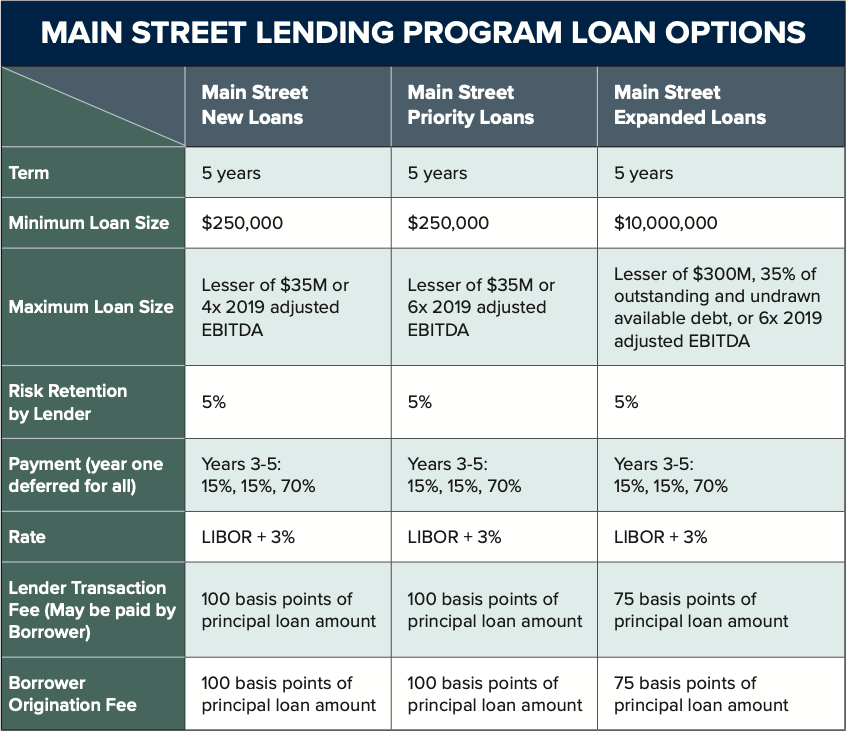Main Street Lending Program Announced
As a result of the Coronavirus Aid, Relief & Economic Security (CARES) Act, the Federal Reserve has created the Main Street Lending Program to provide a total of $600 billion in financing for small and medium-sized businesses.
While the program’s start date has yet to be announced, here’s what you need to know to check eligibility and get ready to apply.
1. Am I eligible?
In order to be eligible for a Main Street Lending Program loan, a business must:
Have been established before March 13, 2020
Not be an ineligible business according to Small Business Administration (SBA) regulations
Have no more than 15,000 employees or 2019 annual revenues of no more than $5 billion
The SBA’s affiliation rules apply in determining the employee and revenue count
In counting employees, the Main Street Lending Program advises businesses to refer to SBA regulations by counting all full-time, part- time, seasonal, or otherwise employed persons, excluding volunteers and independent contractors
Have been created or organized in the U.S. with significant operations in and a majority of its employees based in the U.S.
Not also participate in one of the other Main Street loan facilities, as well as the Primary Market Corporate Credit Facility
Note: Businesses that received support through the SBA Paycheck Protection Program (PPP) are eligible to receive a Main Street loan
Not have received specific support pursuant to the CARES Act (Subtitle A of Title IV for air carriers, air cargo, and businesses critical to national security)
All of the above criteria must be met in order to be eligible.
See “Additional Borrower Criteria” section for more information.
2. How do I apply?
Eligible borrowers must submit an application and other documentation required by an eligible lender. Borrowers should contact lenders for more information on whether the lender plans to participate in the program and for more information on the application process. Additional information about the application process will be announced in the future.
Eligible lenders are U.S. federally-insured depository institutions (including banks, savings associations, and credit unions) as well as any U.S. branch or affiliate of a foreign bank. Nonbank financial institutions are not considered eligible lenders at this time, although the Federal Reserve is considering options to expand this list in the future.
3. How much can I borrow under this program?
The Main Street Lending Program offers three different secured or unsecured 4-year term loan options set at an adjustable rate of LIBOR (1 or 3 month) plus 300 basis points with principal and interest payments deferred for one year for eligible borrowers. Unlike Paycheck Protection Program (PPP) loans, Main Street loans are full-recourse loans and are not forgivable.
All loans under the Main Street Lending Program must permit prepayment without penalty. All loans are made by private financial institutions but backed by the Federal Reserve.
EBITDA: Earnings before interest, tax, depreciation and amortization
LIBOR: London Interbank Offer Rate, a common benchmark interest rate index
Public Reporting
As with other lending facilities, the Federal Reserve announced that it will follow extensive reporting procedures around the Main Street Lending Program by reporting on a monthly basis:
Names and details of participants in each program
Amounts borrowed and interest rate charged
Overall costs, revenues, and fees for each facility
4. Additional Borrower Criteria
If a borrower has outstanding loans with the lender as of December 31, 2019, such loans must have an internal risk rating equivalent to “pass” in the Federal Financial Institutions Examination Council’s supervisory rating system on that date.
Additionally, lenders are expected to conduct an assessment of each potential borrower’s financial condition at the time of application.
In addition to other certifications required by statutes and regulations, the following certifications are required by eligible borrowers:
Borrowers must commit to refrain from repaying principal balance or interest on any debt until the Main Street loan is repaid in full, unless the debt or interest payment is mandatory and due
Borrowers must commit that it will not seek to cancel or reduce any of its committed lines of credit with the Main Street lender or any other lender
Borrower must certify that it has a reasonable basis to believe that, as of the date of origination of the Main Street loan, it has the ability to meet its financial obligations for at least the next 90 days and does not expect to file for bankruptcy during that time period
Borrowers must commit to following compensation, stock repurchase, and dividend restrictions as outlined in the CARES Act for the duration of the loan term plus 1 year
Exception: S-corporations and other tax pass-through entities may continue to make distributions to the extent reasonably required to cover its owners’ tax obligations in respect of the entity’s earnings
Retention of Employees
Eligible borrowers that participate in any Main Street Lending Program facility should make commercially reasonable efforts to maintain its payroll and retain its employees during the time that the term loan is outstanding.
The Federal Reserve further clarifies that to make “commercially reasonable efforts” borrowers should undertake good-faith efforts to maintain payroll and retain employees, in light of its capacities, the economic environment, its available resources, and the business need for labor. Businesses that have already laid-off or furloughed workers as a result of COVID-19 are still eligible to apply for Main Street loans.
For more information, check out the Federal Reserve’s Program Details and FAQs.


